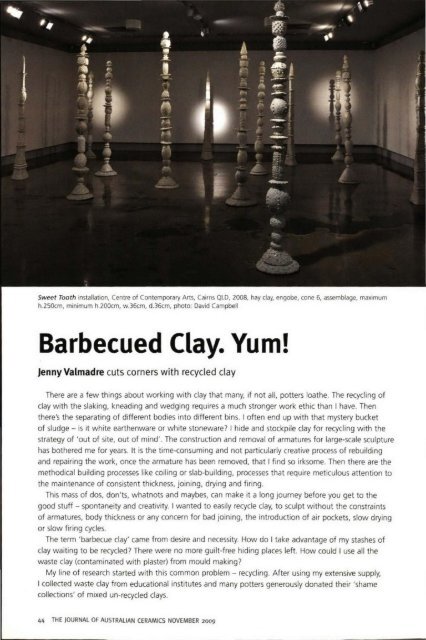The Journal of Australian Ceramics Vol 48 No 3 November 2009
Create successful ePaper yourself
Turn your PDF publications into a flip-book with our unique Google optimized e-Paper software.
Sweet Tooth installation, Centre <strong>of</strong> Contemporary Arts, Cairns QLD, 2008, hay clay, engobe, cone 6, assemblage, maximum<br />
h.2S0cm, minimum h.20Ocm, w.36cm, d.36cm, photo: David Campbell<br />
Barbecued Clay. Yum!<br />
Jenny Valmadre cuts corners with recycled clay<br />
<strong>The</strong>re are a few things about working with clay that many, if not all, potters loathe. <strong>The</strong> recycling <strong>of</strong><br />
clay with the slaking, kneading and wedging requires a much stronger work ethic than I have. <strong>The</strong>n<br />
there's the separating <strong>of</strong> different bodies into different bins. I <strong>of</strong>ten end up with that mystery bucket<br />
<strong>of</strong> sludge - is it white earthenware or white stoneware) I hide and stockpile clay for recycling with the<br />
strategy <strong>of</strong> 'out <strong>of</strong> site, out <strong>of</strong> mind'. <strong>The</strong> construdion and removal <strong>of</strong> armatures for large-scale sculpture<br />
has bothered me for years. It is the time-consuming and not particularly creative process <strong>of</strong> rebuilding<br />
and repairing the work, once the armature has been removed, that I find so irksome. <strong>The</strong>n there are the<br />
methodical building processes like coiling or slab-building, processes that require meticulous attention to<br />
the maintenance <strong>of</strong> consistent thickness, joining, drying and firing.<br />
This mass <strong>of</strong> dos, don'ts, whatnots and maybes, can make it a long journey before you get to the<br />
good stuff - spontaneity and creativity. I wanted to easily recycle clay, to sculpt without the constraints<br />
<strong>of</strong> armatures, body thickness or any concern for bad joining, the introduction <strong>of</strong> air pockets, slow drying<br />
or slow firing cycles.<br />
<strong>The</strong> term 'barbecue clay' came from desire and necessity. How do I take advantage <strong>of</strong> my stashes <strong>of</strong><br />
clay waiting to be recycled? <strong>The</strong>re were no more guilt-free hiding places left. How could I use all the<br />
waste clay (contaminated with plaster) from mould making?<br />
My line <strong>of</strong> research started with this common problem - recycling. After using my extensive supply,<br />
I collected waste clay from educational institutes and many potters generously donated their 'shame<br />
collections' <strong>of</strong> mixed un-recycled clays.<br />
44 THE JOURNAL OF AUSTRALIAN CERAMICS NOVEMBER <strong>2009</strong>


















